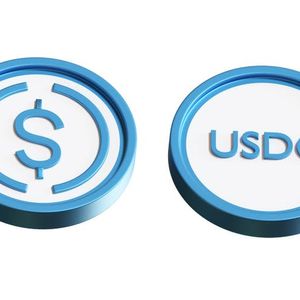
Summary Circle's post-IPO surge is unwarranted; its revenue is almost entirely dependent on short-term interest rates, making it highly vulnerable to rate declines. The GENIUS Act, while providing regulatory clarity, locks Circle into a rate-sensitive reserve model, eliminating the ability to hedge with longer-duration assets. Circle's business lacks diversification and is not differentiated enough to justify its current valuation; a significant multiple contraction is likely. Given the Fed's clear path toward lower rates, Circle's earnings and stock price face substantial downside risk—this is a strong sell at current levels. Overview Circle Internet Group ( CRCL ) surged past a $50b market cap shortly after IPO following the US Senate passage of the GENIUS Act, which provides long-awaited regulatory clarity for stablecoins. This euphoria is misplaced. Circle’s revenue is almost entirely driven by interest on reserves, making it dangerously dependent on short-term rates. Further, the structure of the GENIUS Act actually helps traditional banks more than stablecoin issuers like Circle. The company has reported several years of exceptional revenue growth, but this was due to the rapid ascent of interest rates and the current higher-for-longer environment. A declining rate environment is highly unfavorable for the business, which is already priced to perfection; therefore I believe this is a strong sell. The path of interest rates is clearly set by the Fed's dot plot, and that path is downward. As rates decline, Circle's margin profile weakens. USDC rewards become less attractive. Reserve income growth slows. The stock will be materially impacted both by deterioration of revenue quality and by the resulting multiple contraction. There is far more downside than upside baked into current prices. In this article, I will briefly describe stablecoins and how Circle makes money. I will also discuss why the GENIUS Act passing is actually a bear case hidden in plain sight for Circle. Circle's Business Circle was the second major stablecoin issuer after market leader Tether was founded in 2014. Unlike Tether, which was initially built on the Bitcoin ( BTC ) Blockchain, Circle first built on Ethereum ( ETH ). It has since expanded to several other blockchains, most notably Solana ( SOL ). Tether remains the dominant stablecoin, but Circle's advantage is in its US scale and reserve transparency. USDC owns roughly 26% of the stablecoin market and has a great distribution partnership with the leading crypto exchange Coinbase ( COIN ). Before we delve deeper, let's quickly discuss how stablecoins work. When a user buys USDC, Circle accepts payment in USD and mints one USDC per USD on-chain. When a user sells, the USDC is burned (destroyed) on-chain and USD is returned to the customer. USDC is backed 1:1 with USD, so the price remains pegged to the dollar. The monetization model should be clear from this basic overview. When Circle receives USD and mints USDC, they effectively have float. They are holding real dollars in exchange for the promise of returning those dollars when requested. In the time between deposit and withdrawal, Circle is free to do as they wish, within legal boundaries, with this cash. Considering the inherent call risk, the most sensible option is to invest the float into short-term treasuries. With the passage of the GENIUS Act, stablecoin issuers will be required to hold deposits as either: a) cash, b) demand deposit accounts (checking or savings), or c) short-term treasuries. They then generate 'reserve income' from the interest received. Circle's core business, and over 95% of its revenue for the past three years, is in this 'reserve income'. CRCL Prospectus There's an issue here though. There is little product differentiation inherent in the stablecoin market. They all do the same thing. Therefore, to attract new funds, issuers like Circle must partner with distribution intermediaries to offer rewards to investors for holding a certain stablecoin. Issuers are not allowed to offer rewards directly per the GENIUS Act, which is a major concession to the traditional banking industry. SoFi ( SOFI ) CEO Anthony Noto agrees with this sentiment: X.com He's correct. By inhibiting issuers from offering rewards themselves, the legislation effectively forces them into partnerships like that of USDC and Coinbase. Only 'affiliates' can offer rewards on stables, not the issuer itself. In essence, not only does Circle offer an undifferentiated product in a highly competitive market, but the current regulatory framework limits its ability to effectively monetize the product. And this comprises 99% of their current revenue. Ouch. I view the GENIUS Act as more bearish than bullish for stablecoins broadly. It offers regulatory clarity and legitimacy, sure, but comes with a host of limitations and increasingly burdensome reporting requirements. Washington is extending an olive branch to the traditional banking industry specifically because stablecoins are a better product than demand deposit (checking and savings) accounts and credit cards. The GENIUS Act temporarily protects big banks from disruption. Why do I believe that? Because stables have a structurally better rewards program and a better risk profile. For example, USDC holders on Coinbase earn rewards passively, just for holding cash. Compare this to credit cards, where points are only earned through spending. Next, compare holding cash in USDC versus in a savings account at a bank. Considering the lack of product differentiation, stables need to offer premium rewards and eat away at their margin. It's a race-to-the-bottom pricing game. Contrast this to banks, who lend out their float and keep a majority of the profit on their own books. Customers earn a larger share of the profit in stables versus savings accounts. Further, repayment risk is higher in retail lending than US treasuries. Overall, the Coinbase partnership is critical for Circle to access broad distribution and offer rewards to attract new funds. It comes at a steep cost though. At the time of IPO, Circle and Coinbase shared roughly half of the company's reserve income. About 50% of reserve income with only around 20% of USDC in circulation held on Coinbase. That's a great deal... for Coinbase. CRCL Prospectus The revenue share figure is due to change - it is dependent on how much USDC is held on Coinbase versus other platforms - but the fact remains that a large share of Circle's revenue is lost here. The GENIUS Act would make this partnership much more important though. Coinbase's distribution has allowed USDC to cement itself as a leading stablecoin and build a trusted brand. Still, competition is proliferating from all angles. Traditional finance companies like PayPal ( PYPL ) and Fidelity National Information Services ( FIS ) have built their own native stablecoins. Retail giants like Walmart ( WMT ) and Amazon ( AMZN ) are also reportedly looking into stablecoin technology. There are clear issues with the business model from an investment perspective. While stablecoins have enjoyed mass appeal, Circle's acute reliance on reserve income sets up plenty of downsides. During rampant crypto bull markets, demand for stables declines. Risk-on environments incentivize the traditionally risk-loving crypto investor to stay fully invested. While there is much money to be made in crypto bull markets, much of this is a zero-sum game from the perspective of net dollars sloshing around the ecosystem. Circle's long-term bull case is on net new liquidity entering the ecosystem, which will come from attracting new dollars with rewards. These rewards erode their margin and necessitate revenue sharing with intermediaries. Meanwhile, in protracted bear markets one would expect demand for stability to increase. This is true. However, a bear market increases the likelihood of rate cuts, which further erodes Circle's margin profile and rewards benefits. The counterargument to this is that the company could build a portfolio of long duration debt during elevated rate environments to secure margin, but the passage of the GENIUS Act would make this impossible. Float has to remain fully in short-term, rate sensitive vehicles like savings accounts, short-dated treasuries, and repos. When rates fall, Circle's existing treasury book will appreciate in value, which will temporarily hide the underlying issue. But this will only last for 90 days. It's trivial. For these reasons, it's critically important for Circle to diversify their business away from reserve income. To their credit, management recognizes and understands this. CEO Jeremy Allaire sees Circle as a technology platform, not just a stablecoin issuer. In the coming years, the business certainly could transform, easing its reserve income reliance and expanding into more profitable technology partnerships, but this is fraught with risk. For all the reasons I've discussed, I believe Circle is not an investable stock at current prices. There's just too much risk. Investor Takeaway Circle is a leading stablecoin issuer that took investors by surprise with its rocketing post-IPO performance. The company's business model is straightforward and simple, and it enjoys a strong distribution and scale advantage. The recent passage of the GENIUS Act added further fuel to the fire, but the fact remains that this stock is far overpriced and due for a pullback. The business model is not so differentiated to command such a high multiple, and I believe a material contraction in the stock multiple is due in the coming months. Therefore, I rate CRCL stock a strong sell.
